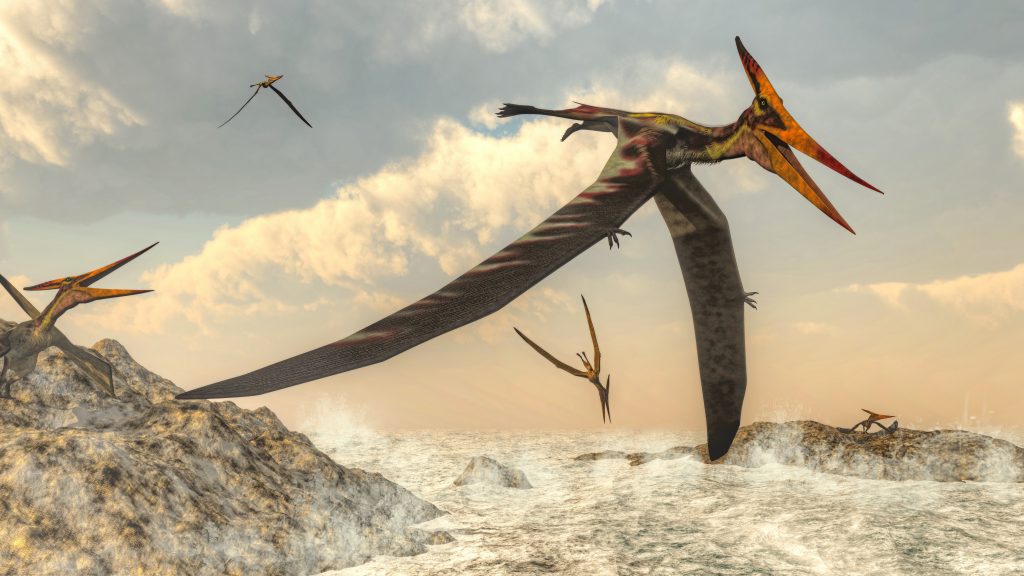
Here’s the original story of flight. Sorry, Wright Brothers, but this story began way before your time during the Age of the Dinosaurs.
Pterosaurs were the earliest reptiles to evolve powered flight, dominating the skies for 150 million years before their extinction some 66 million years ago.
However, key details of their evolutionary origin and how they gained their ability to fly have remained a mystery, one that paleontologists have been trying to crack for the past 200 years. In order to learn more about their evolution and fill in a few gaps in the fossil record, their closest relatives had to be identified.
With the help of newly discovered skulls and skeletons that were unearthed in North America, Brazil, Argentina, and Madagascar in recent years, Virginia Tech researchers Sterling Nesbitt and Michelle Stocker from the Department of Geosciences in the College of Science have demonstrated that a group of “dinosaur precursors,” called lagerpetids, are the closest relatives of pterosaurs.
“Where did pterosaurs come from?’ is one of the most outstanding questions in reptile evolution; we think we now have an answer,” said Nesbitt, who is an associate professor of geosciences and an affiliated faculty member of the Fralin Life Sciences Institute and the Global Change Center.
Their findings were published in Nature.
Fossils of Dromomeron gregorii, a species of lagerpetid, were first collected in Texas in the 1930s and 1940s, but they weren’t properly identified until 2009. Unique to this excavation was a well-preserved partial skull and braincase, which, after further investigation, revealed that these reptiles had a good sense of equilibrium and were likely agile animals.
After finding more lagerpetid species in South America, paleontologists were able to create a pretty good picture of what the lagerpetids were; which were small, wingless reptiles that lived across Pangea during much of the Triassic Period, from 237 to 210 million years ago.
And in the past 15 years, five research groups from six different countries and three continents have come together to right some wrongs in the evolutionary history of the pterosaur, after the recent discovery of many lagerpetid skulls, forelimbs, and vertebrae from the United States, Brazil, Argentina, and Madagascar.
What gave paleontologists the idea to take a closer look at lagerpetids as the closest relatives of pterosaurs? Paleontologists have been studying the bones of lagerpetids for quite some time, and they have noted that the length and shape of their bones were similar to the bones of pterosaurs and dinosaurs. But with the few fossils that they had before, it could only be assumed that lagerpetids were a bit closer to dinosaurs.
What really caused a shift in the family tree can be attributed to the recently collected lagerpetid skulls and forelimbs, which displayed features that were more similar to pterosaurs than dinosaurs. And with the help of new technological advances, researchers found that pterosaurs and lagerpetids share far more similarities than meet the eye.
One stark and mystifying finding was that the flightless lagerpetids had already evolved some of the neuroanatomical features that allowed the pterosaurs to fly, which brought forth even more information on the origin of flight.
Ultimately, the study will help bridge the anatomical and evolutionary gaps that exist between pterosaurs and other reptiles. The new evolutionary relationships that have emerged from this study will create a new paradigm, providing a completely new framework for the study of the origin of these reptiles and their flight capabilities.
“Flight is such a fascinating behaviour, and it evolved multiple times during Earth’s history,” said Serjoscha W. Evers, of the University of Fribourg. “Proposing a new hypothesis of their relationships with other extinct animals is a major step forward in understanding the origins of pterosaur flight.”
Some questions still remain in this evolutionary mystery. Now that lagerpetids are the closest relatives of pterosaurs, why are they still lacking some of the key characteristics of pterosaurs, including the most outstanding of those – wings?
“We are still missing lots of information about the earliest pterosaurs, and we still don’t know how their skeletons transformed into an animal that was capable of flight,” said Nesbitt.
— Written by Kendall Daniels and Steven Mackay




